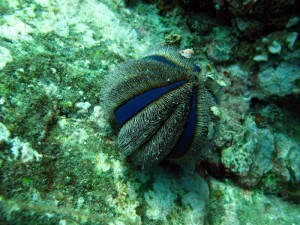Size of a Wahoo
The size of a Wahoo has been known to reach 8 ft or 2.5 m, lengthwise.  On the average they weigh between 10 to 50 lbs. However there are some that reach 150 lbs. There are also some species that can weigh 180 lbs (83 kg). Research shows that some of the fish can swim 50 mph (80 km/h).
On the average they weigh between 10 to 50 lbs. However there are some that reach 150 lbs. There are also some species that can weigh 180 lbs (83 kg). Research shows that some of the fish can swim 50 mph (80 km/h).
Physical Characteristics of the Wahoo
The fish has a long body and is topped with tiny scales that are barely discernible. The sides have a silver hue, while the back has a bluish color. There are also blue bars at the sides. These colors will dissipate when the fish dies.
The fish has a large mouth. The jaws are noticeably sharper compared to those on the mackerel. The jaws and size of a Wahoo are just two of the elements that distinguish it from the Indo-Pacific Narrow-barred Spanish mackerel and Atlantic king mackerel.
Another distinct feature is the fold that conceals the mandible when the Wahoo’s mouth is shut. The mandible is always conspicuous in mackerels, including the king and Spanish mackerel. The Wahoo’s teeth are also shorter and much closer.
Sometimes the Wahoo is mistaken for the Barracuda as well. However, the Barracuda has much bigger teeth. The scales are also more pronounced.
Distribution and Diet
This fish is found in many parts of the world, mostly around subtropical and tropical regions. The fish is known as ono in Hawaii. It is called peto in Central America and the Caribbean. They are also found at weed lines and seamounts.
The fish is oftentimes solitary but some travel with one or two companions. On some occasions, schools of these fish can be found, numbering a hundred. This can happen if the conditions are favorable. The size of a Wahoo can determine its diet; small ones feed on squid while the larger Wahoo eat other bigger fish.
Scientists have determined that a trematode parasite (Hirudinella ventricosa) resides in the stomach of many Wahoo. However this does not seem to have any negative effects on the fish.
Food and Game Fish
Its quality and speed has made the Wahoo one of the most sought after game fish in the world. Another reason is its proximity to land. It is aggressive too, making it a challenge for many sports fishermen.
The fish is also considered a delicacy in many countries. This has led to an increase in the demand for the fish. This is particularly true in Bermuda, Hawaii and the Caribbean. The demand is being met by fishermen who make their living selling this fish.
In spite of the increasing demand, the Wahoo is not as heavily affected by commercial fishing as other species. Although taken by many fisheries, it is not yet overfished.
The speed and size of a Wahoo have made it a favorite among many fishermen, and its taste has made it a prime delicacy too. For this reason, it has become one of the most well known scombrid fish in the world.





